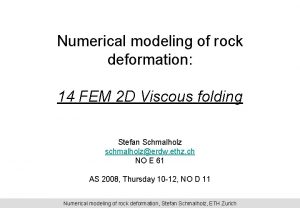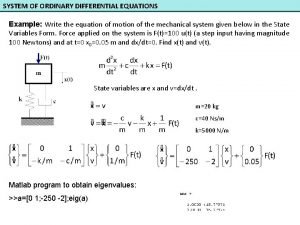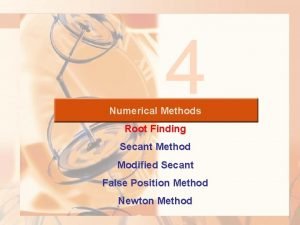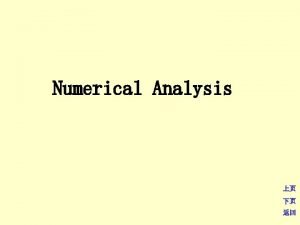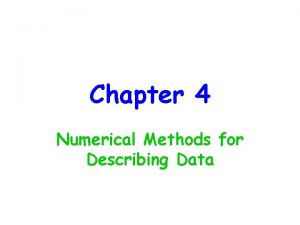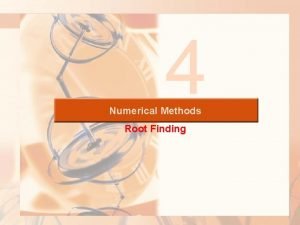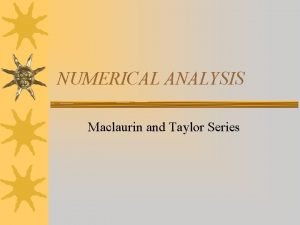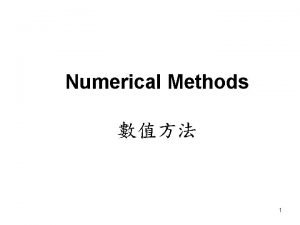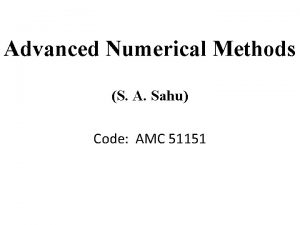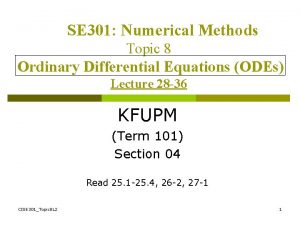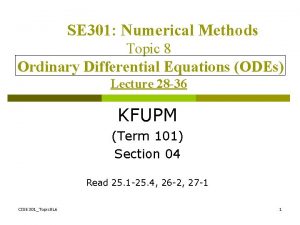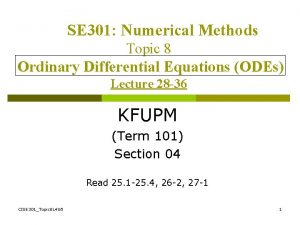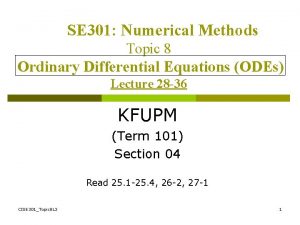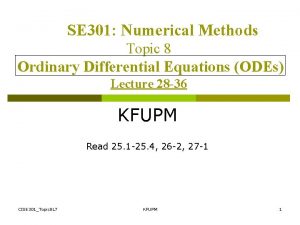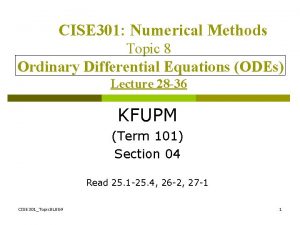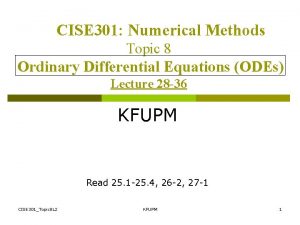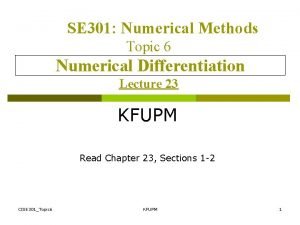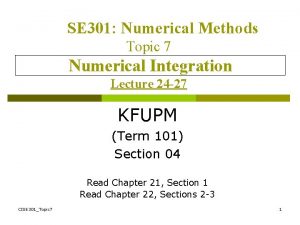SE 301 Numerical Methods Topic 8 Ordinary Differential
























- Slides: 24

SE 301: Numerical Methods Topic 8 Ordinary Differential Equations (ODEs) Lecture 28 -36 KFUPM (Term 101) Section 04 Read 25. 1 -25. 4, 26 -2, 27 -1 CISE 301_Topic 8 L 1 1

Objectives of Topic 8 Solve Ordinary Differential Equations (ODEs). p Appreciate the importance of numerical methods in solving ODEs. p Assess the reliability of the different techniques. p Select the appropriate method for any particular problem. p CISE 301_Topic 8 L 1 2

Outline of Topic 8 Lesson 1: Introduction to ODEs p Lesson 2: Taylor series methods p Lesson 3: Midpoint and Heun’s method p Lessons 4 -5: Runge-Kutta methods p Lesson 6: Solving systems of ODEs p Lesson 7: Multiple step Methods p Lesson 8 -9: Boundary value Problems p CISE 301_Topic 8 L 1 3

Lecture 28 Lesson 1: Introduction to ODEs CISE 301_Topic 8 L 1 4

Learning Objectives of Lesson 1 p Recall basic definitions of ODEs: n n p Classify ODEs based on: n p Order Linearity Initial conditions Solution Order, linearity, and conditions. Classify the solution methods. CISE 301_Topic 8 L 1 5

Derivatives Ordinary Derivatives v is a function of one independent variable CISE 301_Topic 8 L 1 Partial Derivatives u is a function of more than one independent variable 6

Differential Equations Ordinary Differential Equations Partial Differential Equations involve one or more partial derivatives of unknown functions Ordinary derivatives of unknown functions CISE 301_Topic 8 L 1 7

Ordinary Differential Equations (ODEs) involve one or more ordinary derivatives of unknown functions with respect to one independent variable x(t): unknown function t: independent variable CISE 301_Topic 8 L 1 8

Example of ODE: Model of Falling Parachutist The velocity of a falling parachutist is given by: CISE 301_Topic 8 L 1 9

Definitions Ordinary differential equation CISE 301_Topic 8 L 1 10

Definitions (Cont. ) (Dependent variable) unknown function to be determined CISE 301_Topic 8 L 1 11

Definitions (Cont. ) (independent variable) the variable with respect to which other variables are differentiated CISE 301_Topic 8 L 1 12

Order of a Differential Equation The order of an ordinary differential equation is the order of the highest order derivative. First order ODE Second order ODE CISE 301_Topic 8 L 1 13

Solution of a Differential Equation A solution to a differential equation is a function that satisfies the equation. CISE 301_Topic 8 L 1 14

Linear ODE An ODE is linear if The unknown function and its derivatives appear to power one No product of the unknown function and/or its derivatives Linear ODE Non-linear ODE CISE 301_Topic 8 L 1 15

Nonlinear ODE An ODE is linear if The unknown function and its derivatives appear to power one No product of the unknown function and/or its derivatives CISE 301_Topic 8 L 1 16

Solutions of Ordinary Differential Equations Is it unique? CISE 301_Topic 8 L 1 17

Uniqueness of a Solution In order to uniquely specify a solution to an nth order differential equation we need n conditions. Second order ODE Two conditions are needed to uniquely specify the solution CISE 301_Topic 8 L 1 18

Auxiliary Conditions Boundary Conditions Initial Conditions p All conditions are at one point of the independent variable CISE 301_Topic 8 L 1 p The conditions are not at one point of the independent variable 19

Boundary-Value and Initial value Problems Initial-Value Problems p The auxiliary conditions are at one point of the independent variable same CISE 301_Topic 8 L 1 Boundary-Value Problems p p The auxiliary conditions are not at one point of the independent variable More difficult to solve than initial value problems different 20

Classification of ODEs can be classified in different ways: p Order n n n p Linearity n n p First order ODE Second order ODE Nth order ODE Linear ODE Nonlinear ODE Auxiliary conditions n n Initial value problems Boundary value problems CISE 301_Topic 8 L 1 21

Analytical Solutions p Analytical Solutions to ODEs are available for linear ODEs and special classes of nonlinear differential equations. CISE 301_Topic 8 L 1 22

Numerical Solutions Numerical methods are used to obtain a graph or a table of the unknown function. p Most of the Numerical methods used to solve ODEs are based directly (or indirectly) on the truncated Taylor series expansion. p CISE 301_Topic 8 L 1 23

Classification of the Methods Numerical Methods for Solving ODE Single-Step Methods Estimates of the solution at a particular step are entirely based on information on the Multiple-Step Methods Estimates of the solution at a particular step are based on information on more than one step previous step CISE 301_Topic 8 L 1 24
 Numerical methods for partial differential equations eth
Numerical methods for partial differential equations eth Exact differential equation
Exact differential equation Nonlinear ode
Nonlinear ode Ordinary differential equations
Ordinary differential equations Ordinary points
Ordinary points Midpoint method formula
Midpoint method formula Ordinary differential equations
Ordinary differential equations Ordinary differential equations example
Ordinary differential equations example Ppt on differential equations
Ppt on differential equations Secant method numerical analysis
Secant method numerical analysis Newton gregory forward interpolation formula can be used
Newton gregory forward interpolation formula can be used Cubic hermite interpolation
Cubic hermite interpolation Chronicle of higher education
Chronicle of higher education What is cfl number in cfd
What is cfl number in cfd Fixed point iteration method
Fixed point iteration method Taylor series numerical methods
Taylor series numerical methods Pde project topics
Pde project topics Numerical methods of descriptive statistics
Numerical methods of descriptive statistics Numerical methods
Numerical methods Different types of errors in numerical methods
Different types of errors in numerical methods Newton's forward interpolation formula
Newton's forward interpolation formula Graphical method numerical analysis
Graphical method numerical analysis Relative true error formula
Relative true error formula Implicit euler method
Implicit euler method Tapic about internet
Tapic about internet
